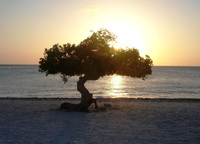Off the beaten track in Aruba

Leave the island's busy beaches and bustling hotels behind and head north instead. Cunucu Arubiano is set in a ruggedly landscape dotted with cacti and divi-divi trees. The detached casitas, all with private patios, are modelled on 19th century Dutch-Aruban architecture with tastefully decorated interiors and original works of art reflecting the island's culture.
Eat: Like your fish fresh? It doesn't come any fresher than Zeerovers. A gem of an eatery, local fishermen sell their daily catch direct to the restaurant: you tell them what you want and they cook it and bring it to your table, overlooking a small wooden pier where the fishermen's boats dock. Completely off the beaten track, Zeerovers is a great spot to wile away the hours and watch the sunset.
Drink: Balashi is the only beer brewed on the island (you can even join a brewery tour) and it will be almost impossible to leave the island without having a bottle or two - but for another rare experience, try an ice cold Amstel Bright. Most people will already be familiar with the popular Amstel beer brand, however only few would know that this version, made with desalinated water, can only be found in Aruba and the former Dutch Antilles.
Buy: Capital Oranjestad remains a haven for shoppers who are after a world-class selection of merchandise but for something a little different explore the local farmer markets and supermarkets, known affectionately as 'the Chinese'. Here you will find unique local products such as pica di papaya hot sauce, coecoei liquor, aloe vera products, as well as local snacks such as the pastechi (a deep-fried half-moon pastry with savoury fillings), pan bollo (Aruban bread pudding) and cocada (coconut candy).
Swim: The seven-mile strip of the Eagle and Palm Beach is consistently voted as one of the top beaches in the world by TripAdvisor, however most locals you will find them at the southeastern end of the island. Baby Beach has taken its name from its shallow waters which are safe enough even for a baby - although many may argue that it is actually because the setting is so romantic that a lot of babies are conceived there. If you want to give yourself a challenge hire a 4WD and head towards Aruba's very own Natural Pool!
Explore: Making up nearly 20 per cent of the island's total landmass, Arikok National Park is home to a number of indigenous species of wildlife, flora and fauna, as well as historical caves, which feature ancient Indian paintings. For a truly unique experience though, you can have a special moon walking tour (naturesensitivetours.com) through the park once a month, when it is full moon, to discover curious shapes and shadows cast by the moonlit cacti and rock formations.
Learn: Unlike most of Aruba's museums, which are within easy reach in Oranjestad, the Aruba Aloe Museum (arubaaloe.com) requires a short drive. Aruba used to be the largest exporter of aloe vera in the world and here you will learn all about its 160-year old history on the island. Unlike other brands, where the substance has a smaller concentration, all Aruba Aloe products contain 100% pure aloe vera gel, which is freshly harvested and processed.
Party: You want to learn how the locals party? Then head to San Nicolas, Aruba's second largest town, on a Thursday evening. The main street closes to traffic, a number of colourful booths pop up and soon music starts to play. It's time for Carubbian, Aruba's weekly event that celebrates the traditions of over 80 nationalities that live on the island. Sample a diversity of cuisines, enjoy a parade of local entertainers, get traditional handicrafts and take part in fun activities for all the family. The best part? Entrance is free.
For more information on visiting Aruba please go to aruba.com.

